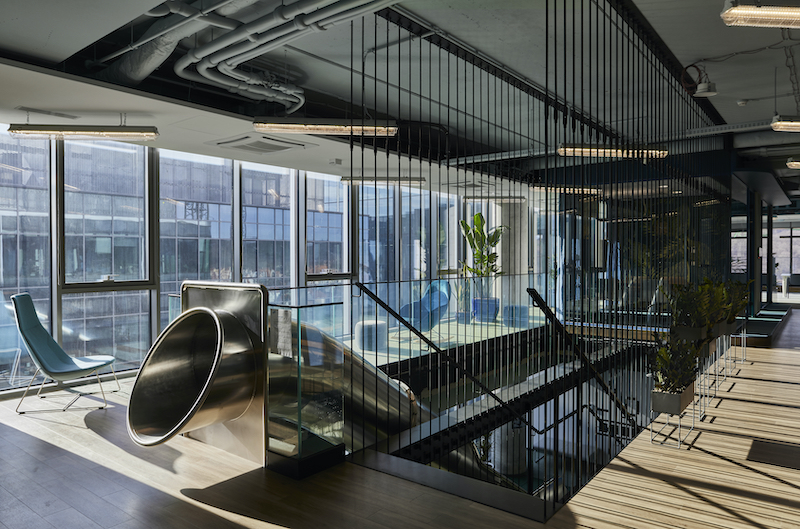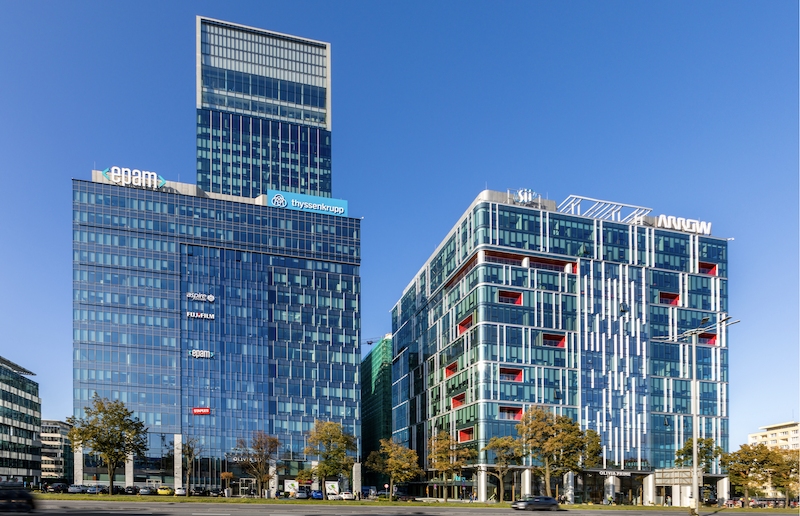The largest office complex in northern Poland is the first building to receive the highest WELL Health Safety Rating, as audited by the International WELL Building Institute (IWBI).
The Olivia Business Center, located in Gdansk, is the complex, with 230,000 sm (2.48 million sf) of office space within eight completed buildings. Olivia Building Center has been expanding since 2010. More than 8,500 people work at Olivia, whose tenants include Amazon, Bayer, PwC, and ThyssenKrupp.
The contractor for the construction of each building has been Pekabex, a leading precast concrete manufacturer. Konior and Partners developed the complex’s architectural concept, which has been continued by Gdynia-based BJK Architekci Studio. The complex’s primary investor is Maciej Grabski, cofounder of Wirtualna Polski (Virtual Poland), one of the country’s big media companies.
A LOCAL DOCTOR HELPS DEVISE SAFETY PROTOCOLS
A spokesperson for Olivia Business Center tells BD+C that the decision to make the buildings healthier stemmed from discussions, in February 2020, with Professor Krzysztof Korzeniewski, MD, Ph.D, the director of the Department of Epidemiology at a regional hospital. Korzeniewski assisted in developing procedures and planning to protect the buildings’ occupants from COVID-19.
The Olivia Business Center is one of the first complexes in the world to install ion air purification technology in its buildings. The devices saturate all internal areas with ventilated air that contains ions capable of destroying viruses, bacteria and other pathogens. The filters in the air handling units were raised to F7 from G4, and sensors for pollution and particulate matter were installed. The intensity of the air exchange in the buildings is controlled based on real-time CO2 measurements.
To maximize tenant safety, key-card sterilizers were installed, and elevator settings changed so that lift cabins stay open while in stay-by mode.
Elevators were among the common areas (including lobbies and access paths to parking lots) to which an active titanium coating was applied to ensure surfaces that are touched often are free from pathogenic organisms. The coating—developed by Lumichem and scientists at Jagiellonian University—eliminates bacteria, fungi, and viruses that come into contact with surfaces, and breaks down their residues into carbon dioxide and water.

Ventilation upgrades were among the improvements made to Olivia Business Center.
A PERFECT SCORE
To achieve its score of 25 out of 25 from IWBI (which launched its rating system last January), Olivia Business Center also made some structural changes to windows and façade in all of the buildings. Inside, occupants are directed by signage to walk in one direction to comply with social distancing guidelines. The frequency of the buildings’ cleaning regimen was increased. Cigarette sales are banned. And the building’s owner organizes free and open-to-everyone healthy activities for occupants, which include Nordic walking, cycling, or yachting excursions on the Baltic Sea.
“The safety and quality of life of our tenants are an absolute priority for us, which is why we were happy to undergo such a thorough and extensive certification process that prioritizes the comfort and well-being of our tenants,” said Konrad Danecki, head of Olivia Business Center’s utilities department, in a prepared statement.
The Center did not disclose the cost of these changes.
Related Stories
| Aug 11, 2010
AIA Course: Enclosure strategies for better buildings
Sustainability and energy efficiency depend not only on the overall design but also on the building's enclosure system. Whether it's via better air-infiltration control, thermal insulation, and moisture control, or more advanced strategies such as active façades with automated shading and venting or novel enclosure types such as double walls, Building Teams are delivering more efficient, better performing, and healthier building enclosures.
| Aug 11, 2010
Glass Wall Systems Open Up Closed Spaces
Sectioning off large open spaces without making everything feel closed off was the challenge faced by two very different projects—one an upscale food market in Napa Valley, the other a corporate office in Southern California. Movable glass wall systems proved to be the solution in both projects.
| Aug 11, 2010
Silver Award: Pere Marquette Depot Bay City, Mich.
For 38 years, the Pere Marquette Depot sat boarded up, broken down, and fire damaged. The Prairie-style building, with its distinctive orange iron-brick walls, was once the elegant Bay City, Mich., train station. The facility, which opened in 1904, served the Flint and Pere Marquette Railroad Company when the area was the epicenter of lumber processing for the shipbuilding and kit homebuilding ...
| Aug 11, 2010
Special Recognition: Durrant Group Headquarters, Dubuque, Iowa
Architecture firm Durrant Group used the redesign of its $3.7 million headquarters building as a way to showcase the firm's creativity, design talent, and technical expertise as well as to create a laboratory for experimentation and education. The Dubuque, Iowa, firm's stated desire was to set a high sustainability standard for both itself and its clients by recycling a 22,890-sf downtown buil...
| Aug 11, 2010
Thrown For a Loop in China
While the Bird's Nest and Water Cube captured all the TV coverage during the Beijing Olympics in August, the Rem Koolhaas-designed CCTV Headquarters in Beijing—known as the “Drunken Towers” or “Big Shorts,” for its unusual shape—is certain to steal the show when it opens next year.
| Aug 11, 2010
Top of the rock—Observation deck at Rockefeller Center
Opened in 1933, the observation deck at Rockefeller Center was designed to evoke the elegant promenades found on the period's luxury transatlantic liners—only with views of the city's skyline instead of the ocean. In 1986 this cultural landmark was closed to the public and sat unused for almost two decades.
| Aug 11, 2010
200 Fillmore
Built in 1963, the 32,000-sf 200 Fillmore building in Denver housed office and retail in a drab, outdated, and energy-splurging shell—a “style” made doubly disastrous by 200 Fillmore's function as the backdrop for a popular public plaza and outdoor café called “The Beach.
| Aug 11, 2010
Integrated Project Delivery builds a brave, new BIM world
Three-dimensional information, such as that provided by building information modeling, allows all members of the Building Team to visualize the many components of a project and how they work together. BIM and other 3D tools convey the idea and intent of the designer to the entire Building Team and lay the groundwork for integrated project delivery.
| Aug 11, 2010
Inspiring Offices: Office Design That Drives Creativity
Office design has always been linked to productivity—how many workers can be reasonably squeezed into a given space—but why isn’t it more frequently linked to creativity? “In general, I don’t think enough people link the design of space to business outcome,” says Janice Linster, partner with the Minneapolis design firm Studio Hive.
| Aug 11, 2010
Great Solutions: Products
14. Mod Pod A Nod to Flex Biz Designed by the British firm Tate + Hindle, the OfficePOD is a flexible office space that can be installed, well, just about anywhere, indoors or out. The self-contained modular units measure about seven feet square and are designed to serve as dedicated space for employees who work from home or other remote locations.







